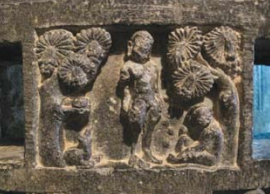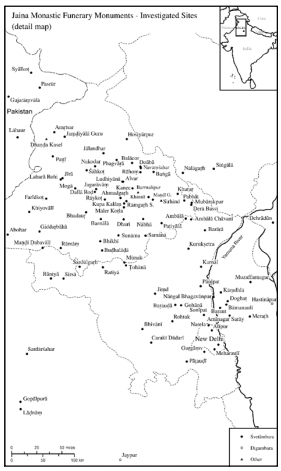
Centre of Jaina Studies Newsletter: SOAS - University of London
The Jainas are widely recognised as the Indian pilgrims par excellence. A plethora of recent studies has therefore investigated Jaina pilgrimage circuits and pilgrimage manuals. So far, research has concentrated almost exclusively either on the annual vihāra of the itinerant Jaina mendicants or on the occasional individual or communal pilgrimages (yātrā) to Jaina sacred places. In most textbooks Jaina sacred places (tīrtha-kṣetra) are depicted as sites marked by temples or shrines housing anthropomorphic images and/or footprint images of Jinas or renowned Jaina saints. Only recently, attention was drawn to the flourishing cult of relic stūpas in medieval and contemporary Jainism. One of the principal findings of recent research at SOAS on Jaina rituals of death is that these stūpas serve as alternative destinations for pilgrimage across almost the entire Jaina sectarian spectrum.[1] This report will point out some of the characteristics of these pilgrimages.

Sallekhanā of a muni under a tree. 10th-century stone relief in the Candragupta Basti in Śravaṇabeḷagoḷa.

From the point of view of Jaina soteriology, attachment to material objects is a form of delusion (mithyātva), and the concept of sacred place, an absurdity.[2] Hence, the Vedic Sanskrit term tīrtha (Pkt. tittha) crossing or ford, originally a designation for bathing places and places of pilgrimage where crossing the ocean of existence (saṃsāra) is deemed possible, was reinterpreted by classical Jainism and given the dual sense of Jaina 'doctrine' and 'fourfold ascetic community' (cāturvarṇya śramaṇasaṅgha), that is, monks, nuns, and male and female laity. (Viyāhapannatti 20.8.72-74) Doctrine and community, the two principal components of the religion, are created by the omniscient tīrtha(ṅ)kara, who is the main object of veneration. Accordingly, the paradigmatic tīrtha in early Jaina literature was the temporary assembly of the fourfold community at the time of the sermon of the Jina, the samavasaraṇa. Later, the semantic range of the Jaina term tīrtha was extended to permanent Jaina pilgrimage places and shrines, possibly following the example of the pilgrimage places mentioned in the Hindu epics.[3] The association of certain places with the legendary five auspicious events, or pañca-kalyāṇakas, in the exemplary lives of the twenty-four Jinas, vividly depicted in the Jinacaritra section of the Kalpasūtra and later in the Jain-Purāṇas, furnished the foundation for the present network of pilgrimage sites. The five auspicious events, including death, are: descent into the womb (garbhaavataraṇa), birth (janma), renunciation (niṣkramaṇa), enlightenment (kevala-jñāna) and salvation (nirvāṇa). Two types of Jaina pilgrimage places were constructed from early medieval times onwards: nirvāṇa-bhūmis, or places of death of the twenty-four Jinas, and kalyāṇa-bhūmis, places associated with the remainder of the five auspicious moments. The locations of some of the named sites, such as the birthplace of Mahāvīra, are disputed between Digambaras and Śvetāmbaras, which developed slightly different overlapping networks of pilgrimage centres and sacred geographies. There is agreement, however, that the places of death of the Jinas are the prime Jaina tīrthas. The places of conception, where the souls of the Jinas descended from heaven into their mothers' wombs, are rarely marked or targeted by pilgrims.
Following Loṅkā, the aniconic Jaina traditions reject as a matter of principle the sacredness of such, rather arbitrarily identified, sites and similar locations connected with the lives of important ācāryas or gods.[4] In their view, only the scriptural understanding of tīrtha as doctrine and community is valid. However, even in the aniconic traditions, at least most of them, it is now customary after cremation of a renowned monk or nun to collect and bury the remaining ashes and charred bones at the cremation site. Usually these samādhi places are only marked by a small cabūtarā, or funeral platform. But increasingly, not with an elaborate samādhi, constructions emerge with chatrīs or śikharas.Whatever its architectural form, any marked site which harbours bone relics of Jaina mendicants can be characterised as a Jaina stūpa.
Numerous Jaina monastic funerary monuments dot the modern landscape of South Asia. Many of them date to the 11th century CE, or in some cases possibly to the 5th century CE. Significantly, there is no archaeological evidence at all on Jaina funeral culture earlier then the famous remnants of the Jaina stūpa at Mathurā, which may or may not have been a funerary monument. It was dated by G. Bühler, on the basis of an optimistic inference, "several centuries before" an excavated inscription of 156/7 CE.[5] No indication for a relic cult of the Jinas exists. The mythical nirvāṇa-bhūmis of the 24 Jinas have only relatively recently been identified and marked with commemorative shrines. The oldest extant Jaina funerary shrines are probably the niṣidhis, seats or resting or cremation places, of a Jaina ascetic, especially one who performs the death-fast. These are in Southern India. Whether the niṣidhis marking the site of the death or cremation of a renowned monk or nun are relic shrines is disputed in the literature. Though in recent years concrete evidence for contemporary Jaina relic practices at the location of specific niṣidhis or samādhis has been published,[6] archaeological research at sacred sites is not possible, and usually there are no inscriptions or signposts indicating the presence of relics at a particular location. Written sources sometimes point to the collection and burial of relics of well-known ascetics at one or another site, and this is standard practice today. The resulting uncertainty as to whether a particular funerary monument is a mere commemorative or a relic shrine is not unintentional. Monastic funerary monuments cannot and should not be venerated with confidence for the presumed power of their relics. At the same time the perception is nurtured that the shrines built over the sites of cremation of Jaina monks and nuns, in a quasi-vedic manner, are miracle shrines (camatkāra-smāraka) worth visiting.


The recent AHRC funded project Jaina Rituals of Death produced for the first time a comprehensive survey of Jaina stūpas in India, that is, niṣidhis and samādhis constructed at the cremation sites of Jaina mendicants. Many of the more recent sites were investigated in detail to confirm the presence or absence of relics, but this was not possible in all cases. Significant is the overall pattern, namely, the existence and current rapid expansion of a third type of multipurpose pilgrimage site with a focus on the sacred remains of deceased Jaina monks or nuns, supplementary or alternative to the existing tīrthas of the image-worshipping Jaina traditions.[7] These remains are either body relics or contact relics, in particular at the site of cremation itself. Most of the kept pilgrimage circuits are regional and not well organised. Most pilgrims come individually or accompanied by their immediate family to venerate the stūpa for its empowering and wish-fulfilling properties. Only on the day of death of the particular monk or nun collective vigils are held at the more popular sites. These pilgrimage circuits both reflect and bolster the predominance of specific monastic orders in a particular socio-geographical field of activity (kāryakṣetra). Only the presumed sites of death of the Jinas have a global and by definition trans-sectarian reach.
The first of two forthcoming books ensuing from this project focuses on the history, doctrines and organisation of the Sthānakavāsī traditions in Northwest India, and maps, as far as possible, the sectarian, biographical and geographical distribution of their funerary monuments in the Panjab, Hariyana, Delhi and Uttar Pradesh.[8] The second volume gives a comprehensive overview of Jaina rituals of death and the relic cult in contemporary Jainism.[9] The first book comprises a complete documentation of the geographic distribution and sectarian affiliation of the monastic funerary monuments of the Loṅkāgaccha and Sthānakavāsī traditions in Northern India. As such it represents a continuation of earlier publications on the history and organisation of the monastic orders of the aniconic Loṅkāgaccha and Sthānakavāsī traditions, published under the designation "protestant and post-protestant Jaina reform-movements". The work focusses on six Sthānakavāsī traditions (sampradāya) and their regional links to the Uttarārddha Loṅkāgaccha, the Kharataragaccha, and the Tapāgaccha which was revived by the ex-Sthānakavāsī Pañjāb Sampradāya monk Ācārya Buddhivijaya (Buṭerāy) (1806-1882) and the ex-Sthānakavāsī Gaṅgarām Jīvarāja Sampradāya monk Ācārya Vijayānandasūri (Ātmārām) (1836-1896). It also comprises an almost complete documentation of the biodata of the monks and nuns and the locations of the samādhis constructed by these Sthānakavāsī traditions.
The overall geographical distribution of the investigated shrines in Northwest India, most of them confirmed relic stūpas, is represented in Figure 1, without details of sectarian affiliation.[10] Figure 2 depicts all Jaina monastic funeral monuments in India that were investigated during the course of the almost ten year long project, the last year of which was funded by the AHRC.
Suffice it to say in this brief report that distinct regional pilgrimage circuits, reflecting the main areas of sectarian vihāras, are nowadays associated with Jaina monastic funerary monuments. Three regions are dominated by Digambara shrines: Bihar and Jharkhand (closely associated with the nirvāṇa-bhūmis of most Jinas), coastal and southern Karnataka, and southern Maharashtra and northern Karnataka. The last two regions have the highest concentration of the Digambara population outside the large metropolises. The Mūrtipūjaka samādhi-mandiras are mostly concentrated in Gujarat. As in the case of the Digambara funerary monuments, despite their growing size and opulence, they are still relatively insignificant as pilgrimage sites and remain in the shadow of the temples and temple cities.
The role of the samādhis is comparatively greater in the present day Terāpanth and in many, but not all, Loṅkāgaccha and Sthānakavāsī sects, that is, monastic orders and lay following that reject image-worship and temple construction. Next to the fourfold community gathering around the itinerant ascetics, the samādhis are here becoming important secondary tīrthas in their own right. Some of these networked pilgrimage sites, such as the samādhis of the extinct Uttarārddha Loṅkāgaccha in the Panjab, the Terāpanth samādhis and those of some of the Sthānakavāsī traditions in Rajasthan, and the highly individualised religious practices associated with them, have been mapped and investigated in toto. Though the project covered the area of South Asia as a whole, the same level of detail as in Northwest India concerning in particular the aniconic traditions could not be achieved everywhere. But the survey of the principal sites clearly established that relic stūpas have been constructed across the entire spectrum of the principal Jaina traditions and function today as secondary tīrthas all over India. Instead of the term tīrtha, however, most aniconic traditions prefer the designation aitihāsik sthal, or historical site.
Acknowledgements
The creation of the unique record of the mortuary cenotaphs in Northwest India was rendered possible through the help of Sādhvī Arcanā and Ācārya Śivmuni and, initially, of Upapravartaka Dineśmuni, all of the Sthānakavāsī Śramaṇasaṅgha. Sādhvī Arcanā on request supplied an almost complete handwritten list of the stūpas in Northwest India, to which only a few others were added later. Ācārya Śivmuni gave his blessings for research and furnished further details of lay contacts and information on god/goddess shrines in the region, which are now integrated in the overlapping pilgrimage circuits of the lay followers of the five surviving now interconnected regional monastic traditions of the Śramaṇasaṅgha. Many of the shrines in the area were visited and studied by the author in 2010-2011 with the untiring support of Sohanlāl Sañcetī of Jodhpur and Narendra Sañcetī and Padam Jain of Amritsar. Puruṣottam Jain and Ravīndra Jain of Māler Koṭlā in particular deserve praise for their enthusiastic voluntary work for the project. Through their network of contacts in the region, and journeys personally undertaken, they collected photographs of the shrines and inscriptions as well as supplementary information. Without their help and their freely shared inside knowledge and records of local history the project could not have been accomplished. They effectively co-authored the resulting data set on Jaina relic shrines in Northwest India based on the initial list of Sādhvī Arcanā. In the same way, all relic shrines in coastal Karnataka were pointed out by Bhaṭṭāraka Cārukīrti (Mūḍabidrī). The project benefitted also from the support of the late Ācārya Mahāprajña of the Terāpanth.
Jaina Studies. Newsletter of the SOAS Centre of Jaina Studies, 6 (2011) 26f. Research was supported by Fellowship AH/I002405/1 of the Arts and Humanities Research Council (AHRC).
'Jainas have decried all forms of respect shown to inanimate objects such as fields, stones, mounds or mountains'. (P.S. Jaini, 'The Pure and the Auspicious in the Jaina Tradition'. Purity and Auspiciousness in Indian Society. Ed. J. B. Carman & F. A. Marglin. Leiden: E. J. Brill, 1985, p. 89.)
Non-Jaina or jainised pilgrimage places are mentioned already in the Jaina scriptures. But they are not associated with lives of Jaina saints. The eternal (anādi), made by the gods, and man-made (sādi) sacred places (tīrtha) of Jambūdvīpa, pointed out in Ṭhāṇa 3.105-108, are abodes of guardian deities vanquished by Jaina cakravartins.
P. Flügel, 'The Unknown Loṅkā: Tradition and the Cultural Unconscious'. In: Caillat, Colette and Balbir, Nalini, (eds.), Jaina Studies. Delhi: Motilal Banarsidas, 2008 (Papers of the 12th World Sanskrit Conference Vol. 9), p. 240, n. 234.
P. Flügel. 'Jaina Relic Stūpas'. Jaina Studies. Newsletter of the SOAS Centre of Jaina Studies, 3 (2008) pp. 18-23; P. Flügel. 'The Jaina Cult of Relic Stūpas'. Numen 57, 3-4 (2010) 389-504.
Cf. G. Schopen. 'Stūpa and Tīrtha: Tibetan Mortuary Practices and an Unrecognized Form of Burial Ad Sanctos at Buddhist Sites in India'. The Buddhist Forum 3 (1994) 273-293; P. Flügel. 'Burial Ad Sanctos at Jaina Sites in India'. International Journal of Jaina Studies (Online) 7, 4 (2011) 1-37.
P. Flügel, Die Sthānakavāsī Śvetāmbara Jaina-Orden in Nordindien. Protestantische und Post-Protestantische Jaina-Reformbewegungen. Zur Geschichte und Organisation der Sthānakavāsī VI. Wiesbaden: Harrassowitz (In Press) (Studies in Oriental Religions 64), ISBN 9783-447-06714-0.
All maps and tables are by Jan Vietmeier: [email protected], Administrative Boundaries: www.gadm.org. For more detailed maps, see Jaina Rituals of Death.
 Dr. Peter Flügel
Dr. Peter Flügel